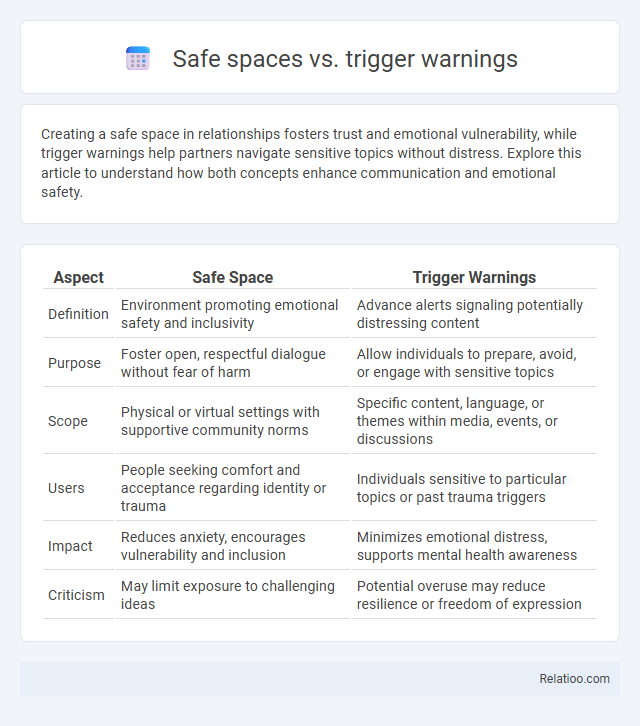Creating a safe space in relationships fosters trust and emotional vulnerability, while trigger warnings help partners navigate sensitive topics without distress. Explore this article to understand how both concepts enhance communication and emotional safety.
Table of Comparison
| Aspect | Safe Space | Trigger Warnings |
|---|---|---|
| Definition | Environment promoting emotional safety and inclusivity | Advance alerts signaling potentially distressing content |
| Purpose | Foster open, respectful dialogue without fear of harm | Allow individuals to prepare, avoid, or engage with sensitive topics |
| Scope | Physical or virtual settings with supportive community norms | Specific content, language, or themes within media, events, or discussions |
| Users | People seeking comfort and acceptance regarding identity or trauma | Individuals sensitive to particular topics or past trauma triggers |
| Impact | Reduces anxiety, encourages vulnerability and inclusion | Minimizes emotional distress, supports mental health awareness |
| Criticism | May limit exposure to challenging ideas | Potential overuse may reduce resilience or freedom of expression |
Understanding Safe Spaces: Definition and Purpose
Safe spaces are environments designed to provide individuals with a supportive and non-judgmental setting that fosters open communication and emotional safety. Their purpose is to protect participants from discrimination, harassment, or emotional harm, enabling marginalized groups to express themselves freely and candidly. Unlike trigger warnings, which serve as alerts to potentially distressing content, safe spaces emphasize a consistent atmosphere of respect and inclusivity.
The Concept of Trigger Warnings Explained
Trigger warnings alert individuals to content that could evoke traumatic memories or emotional distress, enabling Your informed choice to engage or avoid. These warnings aim to create a psychologically safe environment by preemptively signaling potentially harmful material. Unlike safe spaces that provide ongoing emotional support and protection, trigger warnings serve as brief, preventive notices.
Historical Origins: Safe Spaces vs Trigger Warnings
Safe spaces originated in the 1960s civil rights and feminist movements as physical or social environments designed to protect marginalized groups from discrimination and hostility. Trigger warnings emerged later in the late 20th century, particularly in academic and online communities, to alert individuals about content that might provoke traumatic memories or emotional distress. Understanding these distinct historical origins helps you navigate their different purposes: safe spaces offer ongoing protection and support, while trigger warnings provide anticipatory guidance for sensitive content.
Key Differences Between Safe Spaces and Trigger Warnings
Safe spaces provide an environment where individuals can feel secure from discrimination or emotional harm, fostering open and respectful dialogue, while trigger warnings notify you in advance about content that may cause distress or trauma. Safe spaces focus on creating physically and emotionally supportive settings, whereas trigger warnings serve as anticipatory alerts to help prepare or avoid potentially triggering material. Understanding these distinctions enhances your ability to engage empathetically with sensitive topics while maintaining personal boundaries.
Psychological Impact: Safe Spaces in Academic Settings
Safe spaces in academic settings foster environments where students feel secure expressing themselves without fear of judgment or harm, significantly reducing anxiety and promoting mental well-being. Trigger warnings prepare individuals for potentially distressing content, allowing for emotional regulation and preventing re-traumatization, though their psychological efficacy varies among students. Both strategies support psychological safety but differ in approach: safe spaces build ongoing community trust, while trigger warnings provide momentary alerts to mitigate stress responses.
Trigger Warnings and Mental Health Considerations
Trigger warnings play a crucial role in mental health by alerting individuals to content that may evoke traumatic memories or emotional distress, enabling proactive coping strategies. They contribute to creating safer environments by respecting psychological boundaries, which can reduce anxiety and facilitate engagement in educational or social contexts. While safe spaces provide ongoing support and protection, trigger warnings offer a preventative measure that empowers individuals to prepare or opt out, promoting mental well-being and resilience.
Criticisms and Controversies Surrounding Safe Spaces
Criticisms of safe spaces often highlight that they may limit open dialogue and intellectual diversity by creating environments that shield individuals from differing viewpoints. Some argue that trigger warnings can promote avoidance rather than resilience, potentially hindering critical engagement with challenging material. Your experience with safe spaces may vary, but understanding these controversies is essential to navigate their impact on educational and social settings effectively.
Debates on the Effectiveness of Trigger Warnings
Debates on the effectiveness of trigger warnings center around their role in creating safe spaces while balancing academic freedom and mental health support. Critics argue that trigger warnings may inadvertently reinforce avoidance behaviors and limit exposure to challenging content, whereas proponents believe they prepare individuals for sensitive material, fostering a safer environment. Your understanding of these divergent perspectives helps navigate the complex interaction between trigger warnings and safe space policies in educational and social settings.
Balancing Free Speech and Emotional Safety
Balancing free speech and emotional safety involves creating environments where your right to express ideas coexists with sensitivity to others' experiences. Safe spaces provide supportive settings for vulnerable individuals, while trigger warnings alert you to potentially distressing content without restricting dialogue. Implementing these tools thoughtfully encourages open conversations and respects diverse emotional needs.
Best Practices for Implementing Safe Spaces and Trigger Warnings
Implementing safe spaces and trigger warnings requires clear guidelines to foster inclusivity and respect for diverse experiences. Best practices include creating environments where You feel emotionally secure by avoiding content that may cause distress, providing upfront trigger warnings to prepare individuals, and encouraging open communication without judgment. Consistent training for facilitators and regular feedback loops help maintain these spaces as supportive and accessible for everyone involved.

Infographic: Safe space vs Trigger warnings
 relatioo.com
relatioo.com